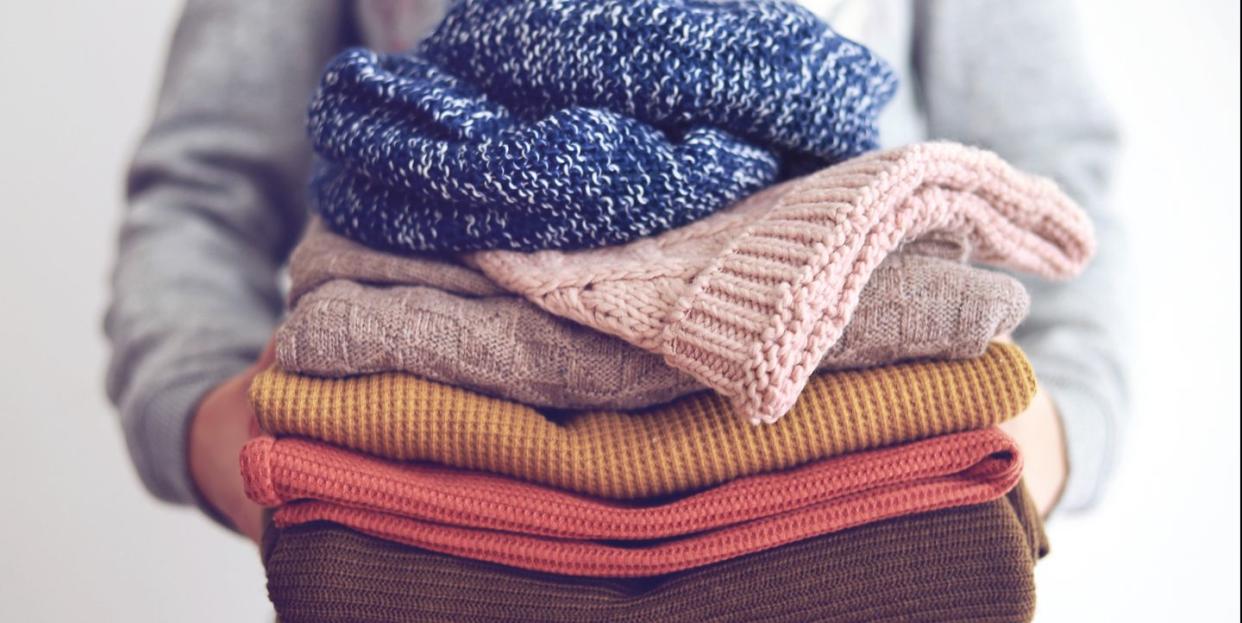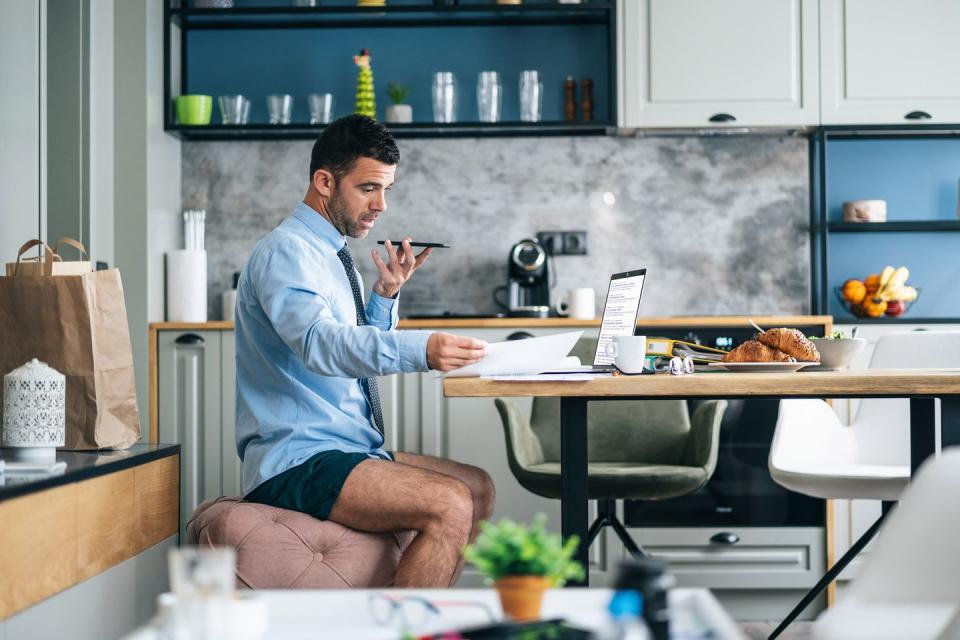The Hard Science Behind Wearing Soft Clothes

It started innocently, as such things often will: a simple pair of cotton joggers from Amazon. One pair led to another, though, followed by an Old Navy binge, on into Lou & Grey, and then the dam was obliterated. We had well and truly succumbed to the siren song of the soft clothes.
It’s not shocking, really. In our new work-from-home reality, many of us are doing the attire version of the mullet, with business up top and leisure down below. There are pajamas that loosely masquerade as “Zoom-appropriate” and nightgown dresses that hide under the guise of “dress.”
Throughout the spring and into the summer, retailers shifted their targets, with Loft, J. Crew, Banana Republic, and the like zeroing in on our presumed interest in all clothes stretchy and fleecy.
While cocooning in all that coziness felt great for a while, there comes a point where you wonder what’s next? We’re more than half a year into pandemic dressing now, and it’s starting to feel more oppressive than comforting. So, why have we been grabbing that stuff? And why are we, just maybe, ready to let it go?
Michelle, a yoga teacher, sees the humor in everyone else’s adoption of her work uniform. “I went to that a long time ago,” she says; of course, there’s a big difference between a yoga instructor wrapped in Lycra and the rest of us attempting the same, but let’s just agree to overlook that distinction. After all, most of us will opt for any relatively acceptable feel-good these days. Dr. Stephanie Hartselle, Clinical Assistant Professor of Psychiatry at Brown University, thinks our stressed-out selves need that physical reassurance. “There is data on the release of oxytocin when we hug or cuddle others,” she observes. “One can imagine that soft clothing signals relaxation and safety [in a similar manner].” A study from VU University Amsterdam found that holding soft toys, like teddy bears, boosts self-esteem and decreases anxiety in adults; it’s not a far stretch, then, that pajama pants and your favorite hoodie incite those warm-fuzzy feelings.

Indulging in something that gives that tactile reinforcement is, Hartselle believes, a relatively harmless mood-booster.
“Soft clothing can provide that comfort we seek without leading to engagement in unhealthy vices like drinking or substance use, escalating screen time, or binge eating,” she says. She herself has embraced the stretchy wardrobe. “[I’m wearing] more than I did, and I can’t imagine going back. Even though I’m a psychiatrist, I am not immune to the stress this year has brought and I, too, need to look for comfort in every healthy way possible.”
Whether that’s changing up the wardrobe or omitting some items entirely — “I’ve organized my workspace so that I do not need a bra when I teach remotely,” Erica, a college professor, responded to a Facebook inquiry about pandemic dressing habits; “What are clothes?” asked Julie, a paralegal — it isn’t surprising that our preferences have changed. Professor Karen Pine from the University of Hertfordshire wrote in her book, Mind What You Wear, that stress causes women to develop clothing tunnel vision, eliminating up to 90 percent of their wardrobe, possibly explaining the wear-wash-repeat cycle many now claim for their favorite pieces.
Some people, though, are sticking it out with clothes as we knew them. Cynthia, an educator, never left hard clothes. “It makes me feel some semblance of normal while also recognizing the utter travesty that is 2020,” she says; Bobbie, a full-time mom, put on hard pants when she had to go out into the world. “They felt like armor,” she explains.
Perhaps that’s the still unanswered part of the equation: in all this softness, will we ever return to the “armor” of suits, heels, and jeans? I put a big box of clothes away in March with no idea of how long it’d be until I’d return to a life that involved cocktail dresses. Of course, when that life might return is still a great big TBD.
Professor Carolyn Mair, Ph.D. in Behavioral Psychology, and author of The Psychology of Fashion thinks we’ll get back there eventually — but the circumstances might look quite different. “There will always be a place for partywear and more formal clothes,” she says. And when we return to physical, rather than virtual, workspaces, some fields might revert to the old ways, but it’s also possible that the old ways will change. “Professions which have unwritten rules, such as business suits, might start leaning towards more business casual clothing,” she says, as the current trend toward athleisure wear could infiltrate into the workplace — a possibility which probably didn’t help dearly departed old-school retailers like Brooks Brothers and Lord & Taylor, which were associated with a certain traditional, upright approach.

Fashion has long embraced a mindset of aesthetics over comfort, from corsets to high heels; perhaps the swing toward a kinder, gentler wardrobe is overdue. Certainly, brands like Everlane, Bonobos, and Eileen Fisher were headed that way even before we started spending all our time on the couch. If this pivot is as widespread as it seems — and it seems vast, given the ongoing effects of the pandemic, including rampant price-slashing — there may not be much tolerance for clothes that bind, pinch, or otherwise cause a literal pain in the ass.
Indeed, now that we’ve discovered that a loose dress feels good and still looks office appropriate, why would we return to a pencil skirt? Sandra, a lawyer, says that she splurged without a backward look. “I bought a cashmere tracksuit and have no regrets!” she says, a sentiment echoed by many; specifically, if we can be physically comfortable and still look professional, why wouldn’t we?
But will our embrace of a more louche attitude toward dressing have negative effects that extend beyond, perhaps, some willful ignorance of weight gain? Research from Columbia University and California State University bore out a correlation between more formal attire and increased abstract processing, the ability to address more open-ended thinking and address questions like “why?” or “what if?”; the study implies that less formal attire could diminish this ability.
On a more macro level, Dr. Jaehee Jung, Professor of Fashion and Apparel Studies at the University of Delaware, thinks casual dress could ultimately create a mindset that’s unhealthily lax; while most offices were already more relaxed than in the past, some, like this article from the American Society for Training & Development, believe that “the way you look directly affects the way you think, feel, and act . . . . When you dress down, you sit down — the couch potato trend. Manners break down, you begin to feel down, and you’re not as effective.” Dr. Jung sees spending time choosing clothes or applying a bit of makeup as self-care to offset the negativity blitz we’re receiving, especially from the media. “We can be distracted from negativity by putting some focus on taking care of ourselves,” she says.
It’s also a small way to counteract massively diminished social reinforcement. “Your level of interaction can impact your appearance,” she says, pointing out that the warmer months’ trend toward greater socializing led many to renew their interest in grooming and attire. As we approach cold weather and a growing likelihood of a viral spike, however, Jung believes that keeping up those more-stringent standards will help us to stay positive and productive. “There’s so much power in what clothes do for ourselves,” she says. “[They create] a more positive mood and outlook… look good, feel good.”
Then again, athleisure already accounted for almost $300 billion in sales in 2018, long before the words “covid,” “pandemic,” or “social distancing” entered our daily vocabulary, so the foundation was clearly laid long ago. Furthermore, yes, there’s much to be said for self-image, professional conduct, and generally maintaining some sense of connection to the before times.
But we’re looking at a need to accept our circumstances as “the new normal,” to let go of the expectation of returning to the way things were. If we are, at least temporarily, relinquishing restaurant dining, live theater and concerts, large-scale social events, and hugging friends — it seems like we should also get a pass on confining waistbands.
Madeleine Deliee writes, teaches, and parents in the Washington, D.C. area. She's written for Playboy, CNN, The Washington Post, SyFy Wire, and many other unrelated outlets. She sometimes tweets about mostly geeky stuff at @MMDeliee.
You Might Also Like


